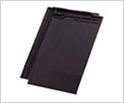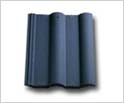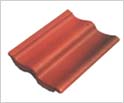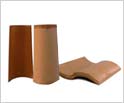Introduction
Depending on the climatic conditions, availability of roof materials, architectural designs, functionality of roofs and other similar factors, different materials such as palm leafs, wood, mud, straw, RCC, Clay tiling, shingles etc. are being used for roofing all over the world, one of the latest being CEMENT ROOF TILES.
Civilizations over the years have developed different roofing concepts based on the materials readily available, the methods, technology and the creativity of the people during the respective time periods.
Ancient history suggests that Chinese were using clay tiles 5000 years ago. Fired roof tiles were found as early as the 3rd millennium BC in Greece.

The above pictures are of the earliest kind of roof tiles found in Greece, where fired tiles began to replace thatched roofs at two temples of Apollo and Poseidon between 700-650 BC. In the next fifty years, Clay Roof tiles were widely used around the Eastern Mediterranean including Mainland Greece, Asia minor, Southern and Central Italy. The early roof tiles had an S-shape, with the pan and cover tile forming one piece.
The clay tiles were more expensive to produce and more labour-intensive than thatched roofing. But its fire resistance and better properties positioned the tiles as a superior product and were used sparingly as a high-end product in the big temples and in premium buildings only.
Monumental architecture in ancient Greece could be a reason for the development of new roof tiles. The stone walls, which replaced the mud walls and wooden walls, were strong enough to support the weight of a tiled roof.
Cement Roof Tiles
The commercial production of roof tiles using cement was started in Bavaria, Germany, by the middle of the 19th century. Subsequently, it was introduced in Europe. These tiles were made with hand or hand operated machines.
The first practical power-driven cement roof tile-making machine was developed in Denmark in the early 1920s. This machine, known as the Ringsted, passed a line of cast-iron pallets or moulds under a hopper that poured a concrete mix into the moulds. Shortly, the Ringsted machine was introduced in England. In 1925, an engineer named William Powell developed a power-driven cement tile machine, which was a considerable improvement over its Danish counterpart. In 1930, H. A. Wilkinson, then managing his father’s factory in Surry, England, decided to eliminate the tedious handwork and designed a more efficient tile-making machine. Tile plants were improved over the years. Now the speed of the Extrusion machine vary from 10 tiles per minute to 150 tiles per minute.
Hydraulic presses were widely used in Japan towards later half of 20th century to produce wide range of concrete roof tiles with exquisite shapes and sizes which extrusion machines could not produce.
In 1961, 82% of all domestic roofs in Great Britain were comprised of concrete tile; the percentage in Australia approached 60% and in Germany concrete tile covered 30% of all new roofs. Recent estimates show that concrete tile now accounts for 90% of all roofs in Europe and the South Pacific basin, with nations such as China, Japan and America beginning to prefer concrete tiles to other roofing materials.
Profiles
A large number of profiles have evolved. These include:
 Flat tiles: The simplest type, which are laid in regular overlapping rows. These tiles are usually made of clay, but also may be made of stone, wood, plastic, concrete or Solar cells.
Flat tiles: The simplest type, which are laid in regular overlapping rows. These tiles are usually made of clay, but also may be made of stone, wood, plastic, concrete or Solar cells.
 Roman tiles: These tiles are flat in the valleys with a concave curve at one end and a convex curve at the other.
Roman tiles: These tiles are flat in the valleys with a concave curve at one end and a convex curve at the other.
 Pan tiles: With an S-shaped profile, allowing adjacent tiles to interlock. These result in a ridged pattern resembling a ploughed field.
Pan tiles: With an S-shaped profile, allowing adjacent tiles to interlock. These result in a ridged pattern resembling a ploughed field.
 Barrel tiles: These are semi-cylindrical tiles laid in alternating columns of convex and concave tiles. Originally, they were made by forming clay around a curved surface. Later these tiles were mass produced from clay, metal, concrete or plastic.
Barrel tiles: These are semi-cylindrical tiles laid in alternating columns of convex and concave tiles. Originally, they were made by forming clay around a curved surface. Later these tiles were mass produced from clay, metal, concrete or plastic.
 Marseille’s Profile : This profile has a double valley shape with interlocks at head . Marseille tile was first produced at the Marseille’s tile works, France. Most of the big clay tiles produced in India are variants of this profile.
Marseille’s Profile : This profile has a double valley shape with interlocks at head . Marseille tile was first produced at the Marseille’s tile works, France. Most of the big clay tiles produced in India are variants of this profile.



